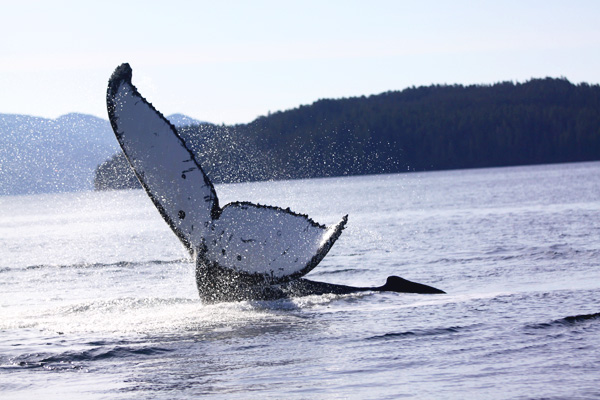Finding Yoda – Part 5
As fall comes to Cetacea Lab, a tiny research station on B.C.’s north coast, whale researcher Janie Wray explores the mysterious underwater song world of humpback whales. The quiet waters of the Great Bear Sea are vital for whale communication, one of the many reasons why WWF is working with Cetacea Lab to protect this special whale habitat. In this blog post, Janie follows the trail of a lone humpback she hears via hydrophone one night encountering, once again, the charismatic Yoda.
Written by Janie Wray, Director of Cetacea Lab
It’s just past midnight on an early October morning. Outside, a silent sea reflects the light from stars shining in the cold, clear sky above. Below the water’s black surface, one lone humpback whale is creating a masterpiece of sound. Through headphones, I listen as a high-pitched call tumbles into a deep moan, echoing off underwater canyons on its way back to where it began.
It seems the whale is taking advantage of the silence of these deep ocean fjords, listening to his echo as he tries out the sounds of a new song. Just as the echo from one call ends, he begins another. By 3 a.m., I decide to get a few hours of sleep so I can be on the water early. I’m anxious to find this late night singer and, with any luck, witness the energetic behavior that accompanies the singing of male humpbacks.
I’m also hopeful that Yoda will be a part of this yearly ritual!
We know that only male humpbacks sing; the reason why remains a mystery. There are many theories – the most popular being that songs are a display to attract a female. Yet, singing males appear to only attract other males! At times, when a male sings, another male will arrive; continuing to gather in small groups to vie for a position next to a female. We call these “posturing groups.” During these competitions, males may become quite aggressive towards one other.
On many occasions, we’ve seen a posturing group all dive at once, returning to the surface moments later, with fresh, bloody scratches along their bodies from their underwater battles. Yoda has shown up many times in these groups, so we’ve assumed this whale is male. Oh, we have so much to learn still about humpbacks here!
Years ago, it was believed that humpbacks would sing only in the winter when mothers were giving birth to calves in southern regions. We now know this isn’t true. Come early fall, our waters in the north are alive with the sounds of humpbacks singing at night – and their vibrant displays of breaching and pectoral slaps during the day. All this energy is devoted to courting a female companion for the migration south.
After last night’s performance, I go in search of posturing whales, finding two small groups. I recognize one female – known as Notch – but it will take time to identify the others because I don’t want to interfere with their courtship display. The groups are swimming back and forth, close to shore. Another whale approaches quickly, anxious to be a part of all this action. When it comes within 50 feet of the group, the whales disappear below the surface. Over 10 minutes go by, and suddenly, there is an explosion of air, as five or six humpbacks burst from the surface, splitting into two groups. I shoot photos of their dorsal fins, trying to determine who is with whom. They head straight for the boat in a diagonal row. One by one, they pass me and I’m delighted to identify the one I was hoping for – YODA!!

The whales dive again and just as I wonder where they’ve gone, a 40-foot body launches itself into the air, crashing down just meters from the boat. I feel both nervous and blessed: For some reason, this group of whales has decided to include our boat in their posturing ritual.
The group repeats this behavior – chasing, breaching, resting and head lobbing for the rest of the day. I simply sit with the boat motor off and watch in awe at this intimate occurrence between these majestic whales. Lost in the moment, time goes by way too fast, and before I know it, daylight is receding. Reluctantly, I start the motor and make my way home, pausing to take one last photo. It’s of Yoda’s famous backwards tail slap reflecting a pinkish hue from the last rays of the sun.
I can only hope they will be singing again this evening!
Learn more about Cetacea Lab’s work.
Learn more about WWF’s work on B.C.’s north coast.
Help protect the Great Bear Sea for now, and forever. Visit Greatbearsea.org and add your name.
